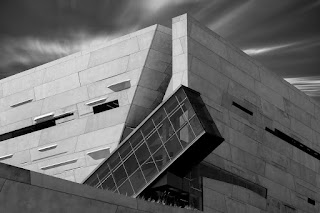Proposal of work
Interior Architecture
Project Overview
I will produce a series of black and white interior photographs of architectural structures. I want to use people in these photographs to create a sense of movement throughout the space. The intention is to create a more balanced portfolio to work from.
Aim
The aim of this series is to create a series of interior photographs of multiple different architectural locations. With the use of people in the photographs, I also hope to achieve a sense of movement throughout the spaces. Farshid Assassi and Alise O’brien are two photographers who I am using as references for this project. They are both admired architectural photographers in the profession. However, unlike these two photographers, I am thinking of using a grayscale in order to exemplify the shadows and highlights throughout the architecture.
 (Farshid Assassi)
(Farshid Assassi) (Alise O’brien)
(Alise O’brien)
Objectives
Due to the nature of interior photography, I will be using a large combination of filters to create the desired effect. I will have a remote in order to control the length of the multiple exposure I will be taking. I am also considering the use of colored gels to help with the interior lighting. To create a balance with the images already in my portfolio, I will create a series of 20 images at the same size, 17 x 24” prints. The images themselves will be a bit smaller, with a 3” border on all sides. An inkjet printer will be used for the duration of the project and the images with it. Many of the interior spaces being photographed will be located in Kansas City and the surrounding areas.
Procedure
I will be using a Canon, Rebel T2i, DSLR for all my images. Through past projects, I have already purchased multiple filters (Such as Red and High Density) as well as a remote timer that I will need to be using for this project. I still need to research and possibly purchase a series of gels to help with the interior shots. While many of the interiors photographed are part of public spaces, I will be obtaining permission for the numerous private locations I have already scouted for this project. Using a tripod and a sketch pad for notes, I will experiment with multiple exposure times as well as angles in which to shoot the locations. As always, I will finish the prints by enhancing them from within photoshop.
Plan of Work/Schedule (Using Class Dates)
August 22 - 31: Finalize my idea as well as begin research
September 5 - 12: Begin experimental shooting, begin receiving permission to photograph spaces
September 14 - 19: Prepare for the first Critique 1 and have a solid plan going forward
September 26 - 28: Travel to Kansas City and begin photographing interiors
October 3: Critique 2 (Print at full size)
October 5: Begin photographing the spaces chosen around Manhattan
October 10 - 12: Have a private critique with colleagues in the school of architecture to get their opinions
October 17 - 19: Critique 3 (Print at full size)
October 24 - 26: Schedule a time to photograph the interiors of the new College of Architecture building on campus
October 31: Critique 4 (Print at full size)
November 2 - 16: Continue editing and enhancing all previously taken photographs. Finish photographing all spaces on and around campus
November 21 - 30: Thanksgiving -Finish photographing all spaces in and around Kansas City, Finish web updating and editing web portfolio
December 5 - 7: Finish everything still not completed. Final Critique (print final images), Hand in all work.
Three images I have attempted in the Bloch Building by Steven Hall in Kansas City
At this point in the project, I am steering towards interior shots such as these three, and towards this image by Joel Tjintjelaar. I am trying to emulate the ghost trails.


















 3 Min
3 Min 2 Min
2 Min 1 Min
1 Min Kansas City Star
Kansas City Star Sprint Center
Sprint Center